Report to Congress: Traumatic Brain Injury in the United States
Historical Document
Note: This report was published in 1999 and is included for historical purposes. See the Get the Facts and Data & Statistics pages for the most current data.
Preface
Prepared by
Division of Acute Care, Rehabilitation Research, and Disability Prevention
National Center for Injury Prevention and Control
Centers for Disease Control and Prevention
U.S. Department of Health and Human Services
December 1999
On this Page
- Preface
- Executive Summary
- Introduction
- CDC's Traumatic Brain Injury Surveillance Program, 1989-1998
- Current Data on Traumatic Brain Injury Mortality and Morbidity
- CDC Estimates of Traumatic Brain Injury-Related Disability
- Public Health Goals
- References
- Appendix: Methods Used to Produce Estimates for This Report
Authors and Contributors
National Center for Injury Prevention and Control
David J. Thurman
Clinton Alverson
Doug Browne
Kathleen A. Dunn
Janet Guerrero
Renee Johnson
Valerie Johnson
Jean Langlois
Diane Pilkey
Joseph E. Sniezek
Susan Toal, Contractor
State Brain Injury Surveillance Programs
Pam Gosler, Arizona Department of Health
Barbara Gabella and Richard Hoffman, Colorado Department of Public Health and Environment
Gail Whiteneck, Craig Hospital, Denver, Colorado
Mark Kinde and Jon Roesler, Minnesota Department of Health
Garland Land and Mark van Tuinen, Missouri Department of Health
Loretta Santilli, Kathleen Thoburn, and Gerald Feck, New York State Department of Health
Pam Archer, Michael Crutcher, and Sue Mallonee, Oklahoma State Department of Health
Ernest McCutcheon and Anbesaw Selassie, Medical University of South Carolina
Leroy Frazier, South Carolina Department of Health
Executive Summary
Public Law 104-166, the Traumatic Brain Injury Act of 1996, authorizes State surveillance systems to obtain information on the number of people affected by traumatic brain injury (TBI), the causes of these injuries, and their severity. As required by this Act, the following Federal report summarizes current knowledge about the incidence, causes, severity, associated disabilities, and prevalence of TBI.
Incidence and Prevalence of Traumatic Brain Injury in the United States
Traumatic brain injury (TBI) is a leading cause of death and disability among children and young adults in the United States. Each year an estimated 1.5 million Americans sustain a TBI. As a consequence of these injuries:
- 230,000 people are hospitalized and survive.
- 50,000 people die.
- 80,000 to 90,000 people experience the onset of long-term disability.
As the cumulative result of past traumatic brain injuries, an estimated 5.3 million men, women, and children are living with a permanent TBI-related disability in the United States today.
While the risk of having a TBI is substantial among all age groups, this risk is highest among adolescents, young adults, and persons older than 75 years. The risk of TBI among males is twice the risk among females. The major causes of TBI are:
- Motor vehicle crashes--the leading cause of TBI resulting in hospitalization.
Violence, especially suicidal behavior and assaults that involve firearms--the leading cause of TBI-related death.
Falls--the leading cause of TBI among the elderly.
These injuries have both short-term and long-term effects on individuals, their families, and society and their financial cost is enormous. According to one study, the annual economic burden in the United States was approximately $37.8 billion in 1985.
For the estimated 5.3 million Americans who live with a TBI-related disability, the financial cost is only part of the burden. The long-term impairments and disabilities associated with TBI are grave and the full human cost is incalculable. Yet because these disabilities are not readily apparent to the public--unlike a broken leg, for example--TBI is referred to as the invisible epidemic. These disabilities, arising from cognitive, emotional, sensory, and motor impairments, often permanently alter a person's vocational aspirations and have profound effects on social and family relationships.
The human face of TBI is suggested by this example, which describes experiences shared by many others:
In 1988, Dr. J.M.Z.—a 44 year-old marriage and family counselor—was struck by a powerboat while kayaking and knocked unconscious for a short time. In the hospital emergency department he was briefly examined, told that he had suffered a "concussion," and sent home an hour later without other treatment. Despite symptoms including headache, fatigue, and memory loss, he returned to his counseling practice. His clients noticed his memory and concentration problems and he had to close his practice in six months.
His health insurance company raised his premium rates until he could no longer afford coverage. His wife divorced him. His applications for Social Security disability income were denied over two years, and for six months he had to live in a van. Finally, he received some Social Security benefits. Years later, he learned about and enrolled in a new college program designed for people with brain injury. He developed ways of partially compensating for his continuing memory and concentration difficulties and re-opened a part-time counseling practice that provides minimal income. Appropriate follow-up from a State TBI registry might have led him to helpful programs earlier.
Measuring Trends in TBI
Rates of TBI-related death have declined 20 percent since 1980, reflecting some success in efforts to prevent such injuries. The decline in TBI-related hospitalization rates has been much greater--about 50 percent since 1980--during a period when efforts to contain health care costs may have led to changes in hospital admissions practices restricting inpatient care. This much larger decline in hospitalization rates suggests that an increasing proportion of persons with less severe TBI may now receive only emergency department outpatient care and are sent home instead of being admitted to hospitals.
If we are to measure the total impact of TBI, the needs for TBI services, and the true injury reductions due to successful prevention, we must include emergency department-based surveillance with surveillance based on hospitalization admissions. Knowing more about the outcomes of TBIs--those treated only in emergency departments as well as those treated in hospitals--is critical in order to assure proper treatment and follow-up.
State follow-up registries, built on surveillance systems, provide more information to help States and communities design, implement, and evaluate targeted, cost-effective programs for people living with TBI and their families, including programs that provide vocational rehabilitation and school and community support. These registries can gather the information needed to:
- Identify the types and frequency of disabilities associated with TBI.
- Assess the need for public health services (e.g., treatment for alcohol abuse or depression) and social services (e.g., job training or marital counseling) for persons with TBI.
- Explain the relationship between the initial severity of the injury and its long-term outcome, to better identify persons needing ongoing medical, rehabilitation, and other services.
To implement more effective programs to prevent these injuries, we must have reliable data on their causes and risk factors. State surveillance systems can provide such data, identify trends in TBI incidence, enable the development of cause-specific prevention strategies focused on populations at greatest risk, and monitor the effectiveness of such programs.
Introduction
Public Health Significance of Traumatic Brain Injury
Traumatic brain injury is a leading cause of death and lifelong disability among children and young adults in the United States. The Centers for Disease Control and Prevention (CDC) has estimated that each year, approximately 1.5 million Americans survive a traumatic brain injury,1 among whom approximately 230,000 are hospitalized.2 Approximately 50,000 Americans die each year following traumatic brain injury, representing one third of all injury-related deaths.3 Adolescents, young adults, and the elderly are at highest risk of these injuries; the most common causes are attributed to motor vehicle crashes, falls, and violence.4
One study estimated that the annual economic burden of TBI in the United States was approximately $37.8 billion in 1985.5 This estimate included $4.5 billion in direct expenditures for hospital care, extended care, and other medical care and services; $20.6 billion in injury-related work loss and disability; and $12.7 billion in lost income from premature death. This study could not account for the intangible costs borne by the families and friends of individuals who die prematurely from brain injury. For injured persons and their loved ones, the physical and emotional tolls from permanent disability are profound and impossible to quantify.
Thus, traumatic brain injuries have a deep impact on the population and require a response from the public health community to prevent these injuries and reduce consequent disabilities. To achieve this goal, the Division of Acute Care, Rehabilitation Research, and Disability Prevention in CDC's National Center for Injury Prevention and Control (NCIPC) has been working since 1989 to develop a traumatic brain injury surveillance system that provides representative data regarding the incidence, risk factors, and causes of traumatic brain injury in the United States and allows comparisons across jurisdictions. The system supports the development, implementation, and evaluation of programs for preventing traumatic brain injury. This effort is enabled, in part, by funding under Public Law 104-166, the Traumatic Brain Injury Act of 1996.
What the Traumatic Brain Injury Act of 1996 Mandates
Public Law 104-166 charges CDC with implementing projects to reduce the incidence of traumatic brain injury. Specifically, the legislation mandates that CDC shall:
- Develop a uniform reporting system for traumatic brain injuries.
- Conduct research into the identification of effective strategies for preventing traumatic brain injury.
- Implement public information and education programs for preventing TBI and for broadening public awareness about the public health consequences of TBI.
- Provide technical assistance, either directly or through grants and contracts, to public or nonprofit entities for planning, developing, and operating projects to reduce the incidence of traumatic brain injury.
- Present a report to Congress that describes the incidence and prevalence of traumatic brain injury.
Funding for all these activities was authorized at $3 million for each of the fiscal years 1997, 1998, and 1999.
CDC's Traumatic Brain Injury Surveillance Program, 1989-1998
Ongoing, population-based surveillance systems--and registries to define disability and other outcomes associated with TBI--are essential for planning and evaluating prevention, acute care, and rehabilitation services for people with these injuries. Yet such systems have only recently been established. Before 1990, most TBI data came from either hospital-based clinical case series or epidemiologic studies that were of limited duration and restricted to particular locales. Despite the limitations of these data sources, they revealed some useful insights into the epidemiology of TBI.
During the 1970s and early 1980s, researchers estimated that each year, about 500,000 Americans sustained a brain injury leading to hospitalization or death.6 The reported annual incidence of TBI in different localities ranged from 132 to 367 injuries per 100,000 population,7-15 with the best estimate of national incidence at about 200 per 100,000 population.16 Different case definitions for TBI and varied methods of collecting data made it difficult to compare information from these studies, combine data across studies, and thus estimate the national incidence of TBI.17 In the case definition, for example, not all studies included skull fractures without other neurologic symptoms, and some excluded immediate deaths that did not involve hospitalization. Most studies focused on limited geographic areas that were not necessarily representative of the United States as a whole. From these studies it was not possible to evaluate U.S. trends in the occurrence of TBI-related hospitalizations.
CDC began promoting the development of a multistate traumatic brain injury surveillance system in 1989 with funding support and technical assistance, after the Federal Interagency Head Injury Task Force Report identified the need for better information on the public health impact of brain injuries.18 The surveillance system's function is to characterize the risk factors, incidence, external causes, severity, and outcomes of traumatic brain injury in the population. Such improved data collection can help achieve two important public health goals:
- Primary prevention. Effective programs should be targeted to address specific causes of TBI and populations at higher risk.
- Acute care and rehabilitation. Accurate data are needed to improved injured persons' access to health care and other necessary services.
In 1995, CDC published Guidelines for Surveillance of Central Nervous System Injury19 to help ensure that the multistate TBI surveillance system would generate valid and timely information representative of the U.S. population. These guidelines provide a standard case definition (Appendix I) of traumatic brain injury (craniocerebral trauma) that can be summarized as an occurrence of injury to the head (arising from blunt or penetrating trauma or from acceleration-deceleration forces) that is associated with symptoms or signs attributable to the injury-- decreased level of consciousness, amnesia, other neurologic or neuropsychologic abnormalities, skull fracture, diagnosed intracranial lesions--or death. The Guidelines also clearly define the data elements necessary to describe the occurrence and severity of these injuries, their external causes, and associated risk factors. The core of these data elements can be obtained from hospital discharge reports, which are readily available to most State health departments.
The most recent developments in CDC's TBI surveillance program include the following:
- In 1995, CDC funded an extensive follow-up study to describe TBI-related disability in Colorado and to develop methods for ongoing studies of longer-term outcomes of TBI in State populations.
- In 1997, CDC published initial findings from the multistate TBI surveillance system, including data from four States: Colorado, Missouri, Oklahoma, and Utah.4 Two of these States (Colorado and Utah) recently published their separate findings.20,21
In September 1997, with the help of funding provided under Public Law 104-166, CDC added 11 States to the system, bringing the total number of participants to 15. Participating States now include Alaska, Arizona, Arkansas, California, Colorado, Louisiana, Maryland, Minnesota, Missouri, Nebraska, New York, Oklahoma, Rhode Island, South Carolina, and Utah. Together, these States are quite representative of the diversity of populations found throughout the United States.
Current Data on Traumatic Brain Injury Mortality and Morbidity
Deaths Nationwide, 1980-1994
Current information on TBI deaths comes from the National Center for Health Statistics for the years 1980-1994.21 In 1994, 51,350 persons died from traumatic brain injury; most of these deaths were related to firearms, transportation (injuries involving motor vehicle occupants, pedestrians, bicyclists, motorcyclists, and others), or falls.
From 1980 through 1994, the TBI-associated death rate in the United States decreased 20 percent, from 24.7 per 100,000 population to 19.8 per 100,000 population (Figure 1). Most of the decrease resulted from a 38 percent decline in transportation-related deaths, from 11.1 per 100,000 population in 1980 to 6.9 per 100,000 in 1994. Rates of TBI-associated death due to falls and other causes also decreased during this period. However, firearm-related TBI deaths increased 11 percent during this period, from 7.6 per 100,000 in 1980 to 8.4 per 100,000 in 1994. Because of this increase, firearms-use surpassed transportation crashes as the leading cause of death from TBI in 1990.

Firearms use has been the leading cause of death from traumatic brain injury since 1990.
In 1994, death rates among males were 3.3 times higher than among females (30.7 per 100,000 males compared with 9.3 per 100,000 females) (Figure 2). Rates were highest among persons aged 75 years and older (46.3 per 100,000), with a smaller peak among those aged 15-24 years (32.8 per 100,000).
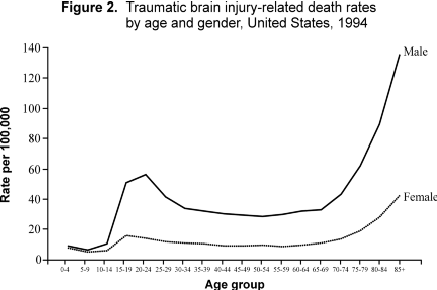
Teens, young adults, and people over 75--especially males--are far more likely than others to die of traumatic brain injury.
Leading causes of TBI-associated death among males varied with age in 1994 (Figure 3). Firearm-related injuries were the leading cause of TBI-associated death among males aged 15-84 years, transportation-related injuries among those under 15 years of age, and falls among those 85 years of age and older.
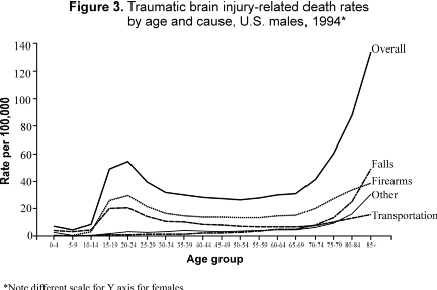
Brain injuries that kill boys and young men are often the result of shootings or motor vehicle crashes.
For females, the leading causes of TBI-related deaths also varied with age. Transportation-related injuries were the leading cause of TBI among females from birth to 74 years of age, although death rates related to firearms and transportation were almost identical among women aged 30-54 years (Figure 4). As in the older male population, falls were the leading cause of TBI-associated death among women 75 years of age and older.
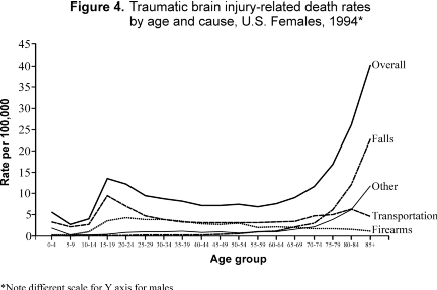
Brain injuries that kill women over 85 are usually the result of falls, whereas brain injures that claim the lives of teenage girls and young women most often occur in motor vehicle crashes.
TBI-associated death rates in 1994 differed by race as well (Figure 5): 25.5 per 100,000 for African Americans; 19.0 per 100,000 for whites; and 15.3 per 100,000 for all other racial groups combined. Among African Americans, firearm-use was the leading cause of TBI-associated death, with a rate of 13.6 per 100,000. This rate was more than two times higher than the rate for the next leading cause, transportation. Firearm-related injuries were also the leading cause of TBI-associated death among whites, with a rate of 7.9 deaths per 100,000--just slightly higher than the transportation-related rate (7.3 per 100,000). Transportation was the leading cause of TBI-associated death among all other racial groups (6.1 per 100,000).
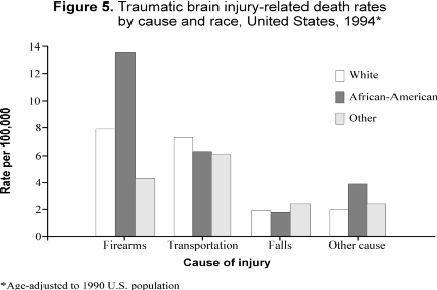
African Americans have a much greater risk of dying from firearm-related traumatic brain injury than do people of other races.
Fatal and Nonfatal Injuries in Seven States, 1994
With financial and technical support from CDC for statewide TBI surveillance systems, seven States (Arizona, Colorado, Minnesota, Missouri, New York [excluding New York City], Oklahoma, and South Carolina) compiled data for TBI-related hospitalizations and deaths that occurred in 1994. As a result, these States have been able to provide more complete descriptions of the incidence, severity, causes, and outcomes of TBI currently occurring among their residents. During 1994, the seven States had 32,112 reported cases of TBI collectively; among persons with these injuries, 5,442 (16.9 percent of all reported TBIs) died without being admitted to a hospital, while 26,670 (83.0 percent) were admitted. Among those who were hospitalized, 1,802 (5.6 percent of all TBIs) died while receiving acute care. Thus, a total of 7,244 TBIs (22.6 percent of all reported TBIs) were fatal.
The annual unadjusted incidence rate of TBI for all seven States combined was 90.9 per 100,000 population (91.8 per 100,000, age-adjusted to the 1990 U.S. population). The crude rate of hospitalizations for TBI in the seven States combined was 75.5 per 100,000. The overall TBI-related death rate was 20.7 per 100,000 (Figure 6). In an assessment of State-specific rates of TBI, serious nonfatal injuries requiring hospitalization were far more common than injuries resulting in death in all seven States. The median age at the time of injury was 32 years. The incidence rate of TBI was highest among persons 75 years of age and older (191.1 per 100,000) and among persons 15-24 years (145.1 per 100,000) (Figure 7). Most TBIs (21,423 or 66.7 percent) occurred among males, with the rate among males (124.1 per 100,000) being about twice the rate among females (59.1 per 100,000).

Serious nonfatal traumatic brain injuries requiring hospitalization greatly outnumber fatal traumatic brain injuries in seven States.

Teenagers, young adults, and people over 75 are far more likely than others to sustain a traumatic brain injury, primarily because of motor vehicle crashes and violence among youths, and falls among the elderly.
Transportation-related crashes (involving motor vehicles, bicycles, pedestrians, and recreational vehicles) accounted for 49 percent of all TBIs; falls accounted for an additional 26 percent (Figure 8). Firearm-use accounted for 10 percent of all TBIs in the seven States, and assaults not involving firearms accounted for 8 percent of reported injuries. Nearly two-thirds of firearm-related TBIs (66.5 percent) were classified as suicidal in intent (Figure 9).
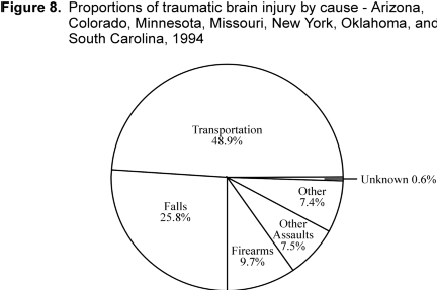
Motor vehicle crashes are by far the leading cause of traumatic brain injury in these seven States and nationally as well. Shootings cause less than 10 percent of all traumatic brain injuries, yet they are the leading cause of TBI-related death.
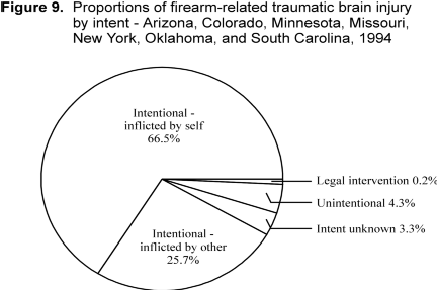
The majority of firearm-related traumatic brain injury represent suicides or suicide attempts, although more than a fourth are the result of assaults by others.
The leading causes of TBI varied by age in the seven States. Falls were by far the leading cause of TBI among persons aged 75 years and older (at a rate of 126.6 per 100,000), whereas transportation led the list for persons aged 15-24 years (97.9 per 100,000) (Figure 10). Analysis also revealed that the severity of injury and the outcome varied depending on the cause. For example, 90.4 percent of firearm-related TBIs resulted in death, but only 10.2 percent of fall-related TBI proved fatal (Figure 11).
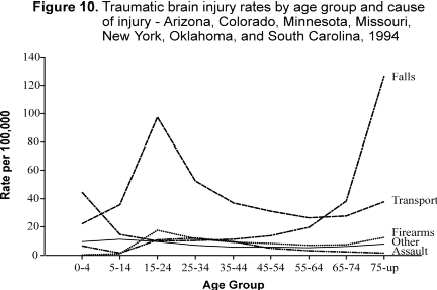
Peak incidence rates in youths are largely related to motor vehicle crashes, whereas peak rates in the elderly are largely related to falls.

People injured in motor vehicle crashes, falls, or assaults without a firearm have a much greater chance of surviving than do those injured in a shooting.
The consistency of findings in these seven States, located in different regions of the United States, suggests that these data may be broadly representative of the Nation as a whole. The epidemiologic patterns of TBI described in this report also resemble those from an analysis of 1994 National Hospital Discharge Survey (NHDS) data, which obtained hospital discharge data from a sample of 478 participating hospitals located across the United States. The crude TBI-related hospitalization rate estimated in the NHDS was 94 per 100,000 population.2 The combined TBI-related hospitalization rate obtained from Arizona, Colorado, Minnesota, Missouri, New York State, Oklahoma, and South Carolina is approximately 20 percent lower than the corresponding rate estimated from the NHDS. Different sampling and other methods that may explain this rate difference have not yet been elucidated.
The rates in this report are substantially lower than rates previously reported in studies conducted from 1974 to 1986 (approximately 200 cases per 100,000 population annually).7-16 In comparison, from 1979 to 1992, the TBI-associated death rate declined 22 percent, largely because of a decrease in TBI-related deaths associated with motor-vehicle crashes.3 The findings in this report and those from the NHDS suggest a decline of approximately 50 percent in combined morbidity and death during a corresponding interval, indicating a disproportionately large reduction in rates of nonfatal TBI resulting in hospitalization. This decrease may reflect successes in injury prevention efforts but may also be the result of recent changes in hospital admission policies that encourage outpatient care for less severe injuries.
This evident shift away from inpatient care underscores the need for surveillance of TBI patients treated in emergency departments and other outpatient settings. The National Center for Health Statistics National Health Interview Survey (NHIS) has provided some information on the incidence of TBI treated on an outpatient basis.1 In 1991, an estimated 1.54 million non-institutionalized U.S. civilians sustained a brain injury that resulted in loss of consciousness but was not severe enough to cause death or long-term institutionalization, according to self-reported NHIS data collected with the 1991 Injury Supplement. Of these 1.54 million persons, 25 percent received no medical care for their TBI, 49 percent received care in an emergency department or other outpatient site, 9 percent received overnight hospital care, and 16 percent were admitted to a hospital for two or more days.
CDC Estimates of Traumatic Brain Injury-Related Disability
Prevalence
The CDC's National Center for Injury Prevention and Control estimates that 5.3 million U.S. citizens (2 percent of the population) are living with disability as a result of a traumatic brain injury. This represents the prevalence of TBI disability, defined as the proportion of persons in the population at a given time who have disability resulting from a traumatic brain injury. To estimate the prevalence of disability from TBI in the United States, CDC developed a model incorporating data on the incidence of TBI, severity of injury, and likelihood of disability given a specific level of injury severity.22 Data come from several sources:
- CDC estimated the incidence of TBI by using its case definition and 1970-1995 National Hospital Discharge Survey (NHDS) data, obtained from CDC's National Center for Health Statistics.1
- CDC estimated the severity of TBI by using NHDS data, classified according to ICD-9-CM-derived Abbreviated Injury Scale23 (ICD/AIS) scores by means of a computer algorithm (ICDMAP-90©).24
- Calculating the likelihood of disability following TBI at each level of severity required two data sources. For injuries occurring in 1980 or after, CDC obtained preliminary follow-up data from the Colorado TBI Registry and Follow-up System,26 which surveyed TBI survivors one year after injury and measured disability by using the Functional Independence Measure.27 For injuries that occurred before 1980, we used historical data reviewed by Kraus.17
The model uses these data to estimate the number of persons alive in 1996 who had ever had a TBI that required hospitalization and resulted in long-term disability. It incorporates differences in rates across age groups, variations in injury severity, and changing patterns in hospital admissions related to severity. The model does not account for disability among people who visited emergency departments or outpatient clinics with a TBI but were not admitted to the hospital. Because of this, our estimate of 5.3 million U.S. citizens living with TBI-related disability may be low. Other restrictions in existing data and methods may also affect the accuracy of this estimate.23 Given these limitations, some variation in future estimates of the prevalence of TBI-related disability is expected.
Incidence
According to NHDS data, the annual incidence rate of TBI hospitalizations has been declining since 1975, when it peaked at 234 per 100,000 population (500,000 cases). During 1990-1995, the mean annual incidence rate for persons hospitalized with TBI and survived was 99 per 100,000 population (260,000 cases). Hospitalization incidence patterns mirrored mortality rate patterns -- the highest rates were among persons 15-24 years of age and persons over age 65. Based on preliminary data from the Colorado TBI Registry and Follow-up System,25,26 we can estimate that each year, approximately 35 percent (80,500) of the 230,000 hospitalized survivors of TBI experience the onset of long-term disability. A small but unknown proportion of the more than 1 million persons with TBI who are not hospitalized may also experience long-term disability. If we assume this proportion is only 1 percent (existing data indicate it is probably greater), an additional 10,000 persons might have long-term disability. Thus, the estimated number of persons who become disabled each year from TBI is between 80,000 and 90,000.
Public Health Goals
The data in this report clearly demonstrate the importance of traumatic brain injury as a public health problem. Consequent to these injuries, each year more than 50,000 Americans die, nearly 230,000 are hospitalized and survive, and an estimated 80,000 to 90,000 experience the onset of long-term or lifelong disability. We have much work to do in these areas: primary prevention, acute care and rehabilitation, and improved data systems. This work requires that we better define groups with an increased risk of injury or adverse outcomes based on population characteristics, e.g., age, sex, and race or ethnicity.
Primary Prevention
Primary prevention of TBI is an important goal of public health efforts. Accomplishing this goal requires attention to each of the major external causes of these injuries: transportation, violence, and falls.
- Transportation crashes are the leading cause of TBI-associated death among women and persons under 15 years of age. Fortunately, the rate of TBI-associated death due to transportation crashes has decreased approximately 40 percent since 1980. This drop is likely because of a combination of factors: an increase in seat belt and child safety seat use, an increase in the number of vehicles equipped with air bags, and a decrease in the incidence of driving while intoxicated. These positive changes should receive continued support. In addition, recent changes in speed limits and in seat belt and helmet use requirements should be evaluated to determine their impact on TBI incidence and death.
- Violence is a leading cause of TBI--especially among males--and violence with firearms is the leading cause of TBI-associated death. Effective programs designed to decrease the occurrence of interpersonal and self-directed violence would help address this cause.
- Falls are the third leading cause of TBI-associated death. Among women over 75 years of age and men over 85 years of age, falls are the leading cause of TBI-associated death. Falls are also a major cause of nonfatal TBI. Risk factors for falls among older persons may include the use of sedative, antidepressant, or other psychotropic medications; and impairments of balance or lower extremity function. Although better data are needed to define the circumstances of fall injuries among older persons, effective interventions may involve modifying the environment to reduce fall hazards and the impacts of falls and, where possible, reducing the use of medications with side effects that increase the risk of falling.
Acute Care and Rehabilitation
An effective public health response to TBI also requires concerted programs to minimize adverse outcomes among persons who do experience injury. We need research activities to improve the acute care and rehabilitation of persons with TBI, strategies to ensure they have access to appropriate care and services, and interventions to promote their independence and integration into the community for persons living with the effects of TBI.
Research to date indicates that the disabilities most often associated with TBI include cognitive, emotional, and--to a lesser extent--sensory and motor impairments. A traumatic brain injury may permanently alter a person's career or vocational aspirations and may also have profound effects on social and family relationships. In part, impairment of cognitive function may result in the loss of communication skills and memory, inability to organize tasks and solve problems, and decreased attention to detail. TBI may also cause emotional instability--especially impulsiveness--and changes in the ability to see, smell, and hear.
To help persons living with the effects of TBI, we need better information on the nature and scope of these disabilities, including who experiences TBIs, which rehabilitation treatment methods are most effective, and what services are useful and readily available.
In the near future, three important developments may increase our knowledge and promote the development of secondary and tertiary prevention programs.
- The National Center on Medical Rehabilitation Research of the National Institutes of Health convened the "Consensus Development Conference on Rehabilitation of Persons with Traumatic Brain Injury" in October 1998. During the conference, experts addressed the epidemiology, consequences, mechanisms of recovery, therapies for cognitive and behavioral impairments, and rehabilitation models for TBI.
- With CDC support, the Colorado Department of Public Health and Environment, Craig Hospital, and the South Carolina Department of Disabilities and Special Needs are developing population-based registries of persons with TBI. Designed as models for other States, these registries will better define the proportion of persons in entire States with various outcomes associated with TBI, the services to which persons with TBI have been referred, and the services that have actually been delivered.
- Twenty-one States are promoting services for people with TBI via demonstration grants from the Health Resources and Services Administration, funded in 1997 under Public Law 104-166.
Improved Data Systems
Finally, more effective, targeted prevention requires better information on the occurrence of TBI and the circumstances surrounding those injuries (for example, the involvement of alcohol and other drugs or the use of personal protective equipment such as helmets). Expanded use of registries facilitates such data collection while also producing more precise information on the impact of these injuries. Standard measures for TBI outcomes need to be refined so that they will readily identify those adverse outcomes most amenable to prevention through rehabilitation and social support. A person's long-term outcome is related to the severity of the TBI. Better defining the relationship between the initial severity of an injury and a person's long-term outcome would help identify those persons who need ongoing medical care, rehabilitation, and other services. Such information also would also help health practitioners and policy makers ensure that these services are available in the community.
References
- Sosin DM, Sniezek JE, Thurman DJ. Incidence of mild and moderate brain injury in the United States, 1991. Brain Injury 1996;10:47-54.
- Centers for Disease Control and Prevention, National Center for Injury Prevention and Control. Unpublished analysis of data from the 1994 National Hospital Discharge Survey, 1998.
- Sosin DM, Sniezek JE, Waxweiler RJ. Trends in death associated with traumatic brain injury, 1979 through 1992. JAMA 1995;273:1778-80.
- Centers for Disease Control and Prevention. Traumatic brain injury, Colorado, Missouri, Oklahoma, and Utah--1990-1993. MMWR, 1997;46:8-11.
- Max W, MacKenzie EJ, Rice DP. Head injuries: costs and consequences. J Head trauma Rehabil 1991;6:76-91
- Kraus JF. Epidemiology of head injury. In: Cooper PR, editor. Head Injury, 3rd ed. Baltimore: Williams and Wilkins, 1993;1-25.
- Annegers JF, Grabow HD, Kurland LT, et al. The incidence, causes and secular trends in head injury in Olmsted County, Minnesota, 1935-1974. Neurology 1980;30:912-9.
- Klauber MR, Barrett-Connor E, Marshall LF, Bowers SA. The epidemiology of head injury: a prospective study of an entire community -- San Diego County, California, 1978. Am J Epidemiol 1981;113:500-9.
- Cooper KD, Tabaddor K, Hauser WA, et al. The epidemiology of head injury in the Bronx. Neuroepidemiology 1983;2:70-88.
- Jagger J, Levine JI, Jane JA, Rimel RW. Epidemiologic features of head injury in a predominantly rural population. J Trauma 1984;24:40-4.
- Kraus JF, Black MA, Hessol N, et al. The incidence of acute brain injury and serious impairment in a defined population. Am J Epidemiol 1984;119:186-201.
- Whitman S, Coonley-Hoganson R, Desai BT. Comparative head trauma experience in two socioeconomically different Chicago-area communities: a population study. Am J Epidemiol 1984;4:560-80.
- Fife D, Faich G, Hollinshead W, Wentworth B. Incidence and outcome of hospital-treated head injury in Rhode Island. Am J Public Health 1986;76:773-8.
- Fife D. Head injury with and without hospital admission: comparisons of incidence and short-term disability. Am J Public Health 1987;77:810-12.
- MacKenzie EJ, Edelstein SL, Flynn JP. Hospitalized head-injured patients in Maryland: incidence and severity of injuries. Maryland Med J 1989;38:725-32.
- Kalsbeek WD, McLaurin RL, Harris BS, Miller JD. The National Head and Spinal Cord Injury Survey: major findings. J Neurosurg 1980;53:S19-24.
- Kraus JF, McArthur DL. Epidemiologic aspects of brain injury. Neurologic Clinics 1996;14(2):435-50
- Department of Health and Human Services. Federal Interagency Head Injury Task Force Report. Washington, D.C.: Department of Health and Human Services, 1989.
- Thurman DJ, Sniezek JE, Johnson D, et al. Guidelines for Surveillance of Central Nervous System Injury. Atlanta: Centers for Disease Control and Prevention, 1995.
- Gabella B, Hoffman RE, Marine WW, Stallones L. Urban and rural brain injuries in Colorado. Ann Epidemiol 1997;7:207-12.
- Thurman DJ, Jeppson L, Burnett CL, Beaudoin DE, Rheinberger MM, Sniezek JE. Surveillance of traumatic brain injuries in Utah. Western J Med 1996;164:192-6.
- Centers for Disease Control and Prevention, National Center for Injury Prevention and Control. Unpublished analysis of data from Multiple Cause of Death Public Use Data, 1997.
- Guerrero JL, Leadbetter S, Thurman DJ, Whiteneck G, Sniezek JE. A method for estimating the prevalence of disability from traumatic brain injury. (Submitted for publication, 1999)
- Association for the Advancement of Automotive Medicine. The Abbreviated Injury Scale, 1990 Revision. Des Plains (IL): Association for the Advancement of Automotive Medicine, 1990.
- Center for Injury Research and Policy of the Johns Hopkins University School of Public Health. ICDMAP-90 Software. Baltimore, MD: The Johns Hopkins University and Tri-Analytics, Inc., 1997.
- Brooks CA, Gabella B, Hoffman R, Sosin D, Whiteneck G. Traumatic brain injury: designing and implementing a population-based follow-up system. Arch Phys Med Rehabil 1997; 78(8):S26-S30.
- Whiteneck G. Personal communication, 1998.
- Research Foundation, State University of New York. Guide for use of the uniform data set for medical rehabilitation including the functional independence measure (FIM) and functional assessment measure (FAM), version 4.0. Buffalo, NY: State University of New York, 1995.
Appendix: Methods Used to Produce Estimates for This Report
CDC Case Definition for Traumatic Brain Injury
CDC issued the following case definition for traumatic brain injury in its 1995 publication, Guidelines for Surveillance of Central Nervous System Injury.1
For the purposes of public health surveillance, jurisdictions may elect to ascertain cases of traumatic brain injury from clinical records or from existing uniform data systems. Case definitions are presented for both types of ascertainment.
Clinical Case Definition. For surveillance systems using data from clinical records, a case of traumatic brain injury (craniocerebral trauma) is defined either:
as an occurrence of injury to the head that is documented in a medical record, with one or more of the following conditions attributed to head injury:*
- observed or self-reported decreased level of consciousness,†
- amnesia,‡
- skull fracture,
- objective neurological or neuropsychological abnormality,§ or
- diagnosed intracranial lesion;||
- or as an occurrence of death resulting from trauma, with head injury listed on the death certificate, autopsy report, or medical examiner's report in the sequence of conditions that resulted in death.
*Injuries to the head may arise from blunt or penetrating trauma or from acceleration-deceleration forces.
†Decreased level of consciousness refers to partial or complete loss of consciousness. This includes states described as obtundation, stupor, or coma.
‡Amnesia may include loss of memory for events immediately preceding the injury (retrograde amnesia), for the injury event itself, and for events subsequent to the injury (posttraumatic amnesia).
§Neurological abnormalities are determined from neurological examination. Examples include abnormalities of motor function, sensory function, or reflexes; abnormalities of speech (aphasia or dysphasia); or seizures acutely following head trauma. Neuropsychological abnormalities are determined from mental status and neuropsychological examinations. Examples include disorders of mental status (such as disorientation, agitation, or confusion) and other changes in cognition, behavior, or personality.
||Examples of diagnosed intracranial lesions include traumatic intracranial hematomas or hemorrhage (epidural, subdural, subarachnoid, or intracerebral), cerebral contusions or lacerations, or penetrating cerebral injuries (e.g., gunshot wounds). The diagnosis of such intracranial lesions is usually confirmed with a computed tomography (CT) or magnetic resonance imaging (MRI) brain scan or by other neurodiagnostic procedures.
The clinical definition of traumatic brain injury excludes the following:
- lacerations or contusions of the face, eye, ear, or scalp, without other criteria listed above
- fractures of facial bones, without other criteria listed above
- birth trauma
- primary anoxic, inflammatory, infectious, toxic, or metabolic encephalopathies which are not complications of head trauma
- neoplasms
- brain infarction (ischemic stroke) and intracranial hemorrhage (hemorrhagic stroke) without associated trauma
Data Systems Case Definition. For surveillance systems receiving case reports from coded death certificates or hospital discharge data, the following International Classification of Diseases, Ninth Revision (ICD-9)2 or International Classification of Diseases, Ninth Revision, Clinical Modification (ICD-9-CM)3 diagnostic codes¶ are included in the definition of traumatic brain injury:
- 800.0-801.9 Fracture of the vault or base of the skull
- 803.0-804.9 Other and unqualified and multiple fractures of the skull
- 850.0-854.1 Intracranial injury, including concussion, contusion, laceration, and hemorrhage.
Additional cases of traumatic brain injury may be ascertained from death certificates coded as follows:
- 873.0-873.9 Other open wound of head.**,4
¶Note: ICD-9 codes are used for coding death certificates. ICD-9-CM codes are used for morbidity data. The codes are comparable except that ICD-9-CM codes include a fifth digit not found in ICD-9 codes.
**Note: This code range should not be applied to intracranial injuries. However, reviews of multiple cause mortality data from death certificates indicate that a substantial number of cases of intracranial injury, especially gunshot wounds, are mistakenly given these codes.3 Suspected cases of head trauma which have been so coded may be confirmed by review of medical records or death certificates.
Surveillance Methods Used by States
State health departments in Arizona, Colorado, Minnesota, Missouri, Oklahoma, New York, and South Carolina reviewed hospital discharge data collected from January 1 to December 31, 1994, using CDC guidelines to identify cases of TBI. The review identified all cases of TBI among patients in acute care hospitals who had been discharged with primary or secondary diagnoses consistent with the CDC case definition (i.e., ICD-9-CM code ranges 800.0-801.9, 803.0-804.9, and 850.0-854.1). In addition, the review identified TBI-related deaths and collected information from all death certificates or medical examiner reports that listed TBI or head injury among the conditions associated with death. Records were linked to eliminate duplicate cases reported from more than one source. Surveillance in New York excluded residents of New York City. Surveillance was statewide in all other States. In most States, supplementary information on severity and external cause of injury was obtained from abstracts of medical records or health-care provider report forms for all cases (Missouri and Oklahoma) or from representative samples of cases (Arizona [31 percent sample], Colorado [47 percent sample], and South Carolina [45 percent sample]). The TBI incidence rate for all seven States combined was calculated by using the sum of the number of cases for each State and the sum of the population of each State estimated at the midpoint of 1994 (35.3 million total).
Appendix References
- Thurman DJ, Sniezek JE, Johnson D, et al. Guidelines for Surveillance of Central Nervous System Injury. Atlanta: Centers for Disease Control and Prevention, 1995.
- International Classification of Diseases, 9th Revision (ICD-9). Geneva, Switzerland: World Health Organization, 1977.
- International Classification of Diseases, 9th Revision, Clinical Modification, 3rd ed. (ICD-9-CM). Washington DC: U.S. Department of Health and Human Services, 1989.
- Sosin DM, Nelson DE, Sacks JJ. Head injury deaths: the enormity of firearms. JAMA 1992;268:791.
- Page last reviewed: January 22, 2016
- Page last updated: January 22, 2016
- Content source:
- Centers for Disease Control and Prevention,
- National Center for Injury Prevention and Control,
- Division of Unintentional Injury Prevention


 ShareCompartir
ShareCompartir
